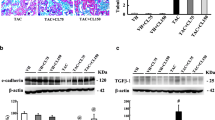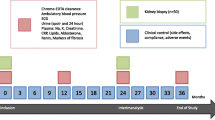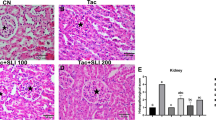Abstract
Tacrolimus (TAC), a widely used nephrotoxic calcineurin inhibitor, is associated with renal vasoconstriction possibly through adenosine receptor activation. Theophylline (THEO), an adenosine receptor inhibitor, protects against the nephrotoxicity of drugs associated with renal vasoconstriction. We hypothesized that coadministration of low dose THEO in rats would prevent TAC-induced nephrotoxicity. Sprague-Dawley rats pair-fed a low-sodium diet were randomized into three groups (n=10/group): the control (CONTROL) group received the vehicle for both medications; the TAC group received TAC 6 mg/kg/day and vehicle; and the TAC+THEO group received TAC and THEO 17 mg/kg/day. On day 21, a timed urine collection was obtained for creatinine clearance. On day 22, serum creatinine, THEO and whole blood TAC concentrations were determined. One kidney was removed for formalin fixation and histological assessment. In the TAC group, serum creatinine increased while creatinine clearance decreased compared to CONTROL (0.3±0.0 vs. 0.4±0.0 mg/dl and 0.53±0.06 vs. 0.34±0.04 ml/min/100 g body weight respectively, p<0.05), while TAC+THEO did not differ from control. There were no significant differences in renal histology. Concurrent administration of low-dose THEO prevented the TAC-induced decline in renal function, consistent with a role for adenosine in TAC-induced nephrotoxicity.

Similar content being viewed by others
References
Dumont F, Staruch MJ, Koprak SL, Sierkaka JJ (1992) The immunosuppressive and toxic effects of FK-506 are mechanistically related: pharmacology of a novel antagonist of FK-506 and rapamycin. J Exp Med 176:751–760
Goldstein DJ, Zuech N, Sehgal V, Weinberg AD, Drusin R, Cohen D (1997) Cyclosporine-associated end-stage nephropathy after cardiac transplantation: incidence and progression. Transplantation 63:664–668
Winkler M, Jost U, Ringe B (1991) Association of elevated FK506 plasma levels with nephrotoxicity in liver-grafted patients. Transplant Proc 23:3153–3155
Messana JM, Johnson KJ, Mihatsch MJ (1995) Renal structure and function affects after low dose cyclosporine in psoriasis patients: a preliminary report. Clin Pathol 43:180–183
McDiarmid SV, Colonna JO II, Shaked A, Ament ME, Busuttil RW (1993) A comparison of renal function in cyclosporine and FK506-treated patients after primary orthotopic liver transplant. Transplantation 56:847–853
Davies D, Bittmann I, Pardo J (2000) Histopathology of calcineurin inhibitor-induced nephrotoxicity. Transplantation 69:SS11–SS13
Bagnis C, Deray G, Dubois M, Adabra Y, Jacquiaud C, Jaudon MC, Jacobs C (1997) Comparative acute nephrotoxicity of FK-506 and cyclosporine in an isolated in situ autoperfused rat model. Am J Nephrol 17:17–24
Prevot A, Semama D, Tendron A, Justrabo E, Guignard JP, Gouyon JB (2000) Endothelin, angiotensin II, and adenosine in acute cyclosporine nephrotoxicity. Pediatr Nephrol 14:927–934
Guieu R, Dussol B, Devaux C, Sampol J, Brunet P, Rochat H, Bechis G, Berland YF (1998) Interactions between cyclosporine A and adenosine in kidney transplant recipients. Kidney Int 53:200–204
Hwang K, Hall CS, Spielman WS, Sparks HV (2001) FK506 promotes adenosine release from endothelial cells via inhibition of adenosine kinase. Eur J Pharmacol 425:85–93
Osswald H (1975) Renal effects of adenosine and their inhibition by theophylline in dogs. Naunyn Schmiedebergs Arch Pharmacol 288:79–86
Osswald H, Gleiter C, Muhlbauer BP (1995) Therapeutic use of theophylline to antagonize renal effects of adenosine. Clin Nephrol 43:S33–S37
Heidemann HT, Gerkens J, Jackson E, Branch RA (1983) Effect of aminophylline on renal vasoconstriction produced by amphotericin B in the rat. Naunyn Schmiedebergs Arch Pharmacol 324:140–152
Heidemann HT, Muller S, Mertins L, Stepan G, Hoffmann K, Ohnhaus EE (1989) Effect of aminophylline in Cisplatin nephrotoxicity in the rat. Br J Pharmacol 97:313–318
Erley C, Dauda S, Schlepckow S, Koehler J, Huppert RE, Strohmaier WL, Bohle A, Risler T, Osswald H (1994) Adenosine antagonist theophylline prevents reduction of glomerular filtration rate after contrast media application. Kidney Int 45:1425–1431
Andoh T, Burdmann E, Lindsley J, Houghton DC, Bennett WM (1994) Enhancement of FK 506 nephrotoxicity by sodium depletion in an experimental rat model. Transplantation 57:483–489
Husdan H, Rappoport A (1968) Estimation of creatinine by the Jaffe reaction. A comparison of three methods. Clin Chem 14:222–238
Dietemann J, Berthoux P, Gay-Montchamp JP, Batie M, Berthoux F (2001) Comparison of ELISA method versus MEIA method for daily practice in the therapeutic monitoring of tacrolimus. Nephrol Dial Transplant 16:2246–2249
Hanauer SB, Dassapoulos T (2001) Evolving treatment strategies for inflammatory bowel disease. Annu Rev Med 52:299–318
Assmann T, Homey B, Ruzicka T (2000) Applications of tacrolimus for the treatment of skin disorders. Immunopharmacology 47:203–213
Arai S, Vogelsang GB (2000) Management of graft-versus-host disease. Blood Rev 14:190–204
Fassi A, Sangalli F, Colombi F, Perico N, Remuzi G, Remuzzi A (1999) Beneficial effects of calcium channel blockade on acute glomerular hemodynamic changes induced by cyclosporine. Am J Kidney Dis 33:267–275
Mitamura T, Yamada A, Ishida H, Fujihira S, Ohara K, Noguchi H, Mine Y (1994) Tacrolimus (FK506)-induced nephrotoxicity in spontaneous hypertensive rats. J Toxicol Sci 19:219–226
Schrama YC, Koomans HA (1998) Interactions of cyclosporine A and amlodipine: blood cyclosporine a levels, hypertension and kidney function. J Hypertens 16:S33–S38
Raman GV, Campbell SK, Farrer A, Albano JDM, Cook J (1988) Modifying effects of amlodipine on cyclosporine A-induced changes in renal function in patients with psoriasis. J Hypertens 16:S39–S41
Van Riemsdijk I, Mulder PG, De Fijter JW, Bruijn JA, Van Hooff JP, Hoitsma AJ, Tegzess AM, Weimar W (2000) Addition of isradipine (lomir) results in a better renal function after kidney transplantation: double blind, randomized, placebo-controlled, multi-center study. Transplantation 70:122–126
Osswald H, Schmitz HJ, Heidenreich O (1975) Adenosine response of the rat kidney after saline loading, sodium restriction and hemorrhagia. Pflugers Arch 357:323–333
Potier M, Aparico M, Cambar J (1997) Protective effect of three xanthine derivatives (theophylline, caffeine and pentoxifylline) against the cyclosporine A-induced glomerular contraction in isolated glomeruli and cultured mesangial cells. Nephron 77:427–434
Prevot A, Liet JM, Semama DS, Justrabo E, Guignard JP, Gouyon JB (2002) Disparate effects of chronic and acute theophylline on cyclosporine A nephrotoxicity. Pediatr Nephrol 17:418–424
Boubenider S, Vincent I, Lambotte O, Roy S, Hiesse C, Taburet AM, Charpentier B (2000) Interaction between theophylline and tacrolimus in a renal transplant patient. Nephrol Dial Transplant 15:1066–1068
Stillman I, Andoh T, Burdmann E (1995) FK 506 nephrotoxicity: morphologic and physiologic characterization of a rat model. Lab Invest 73:794–803
Matsuda H, Iwasaki K, Shiraga T (1996) Interactions of FK506 (TAC) with clinically important drugs. Res Commun Mol Pathol Pharmacol 91:57–64
Acknowledgements
This work was supported in part by a grant from the Kidney Foundation of South Florida.
Author information
Authors and Affiliations
Corresponding author
Rights and permissions
About this article
Cite this article
McLaughlin, G.E., Schober, M., Perez, M. et al. Benefit of theophylline administration in tacrolimus-induced nephrotoxicity in rats. Pediatr Nephrol 18, 860–864 (2003). https://doi.org/10.1007/s00467-003-1196-z
Received:
Revised:
Accepted:
Published:
Issue Date:
DOI: https://doi.org/10.1007/s00467-003-1196-z




